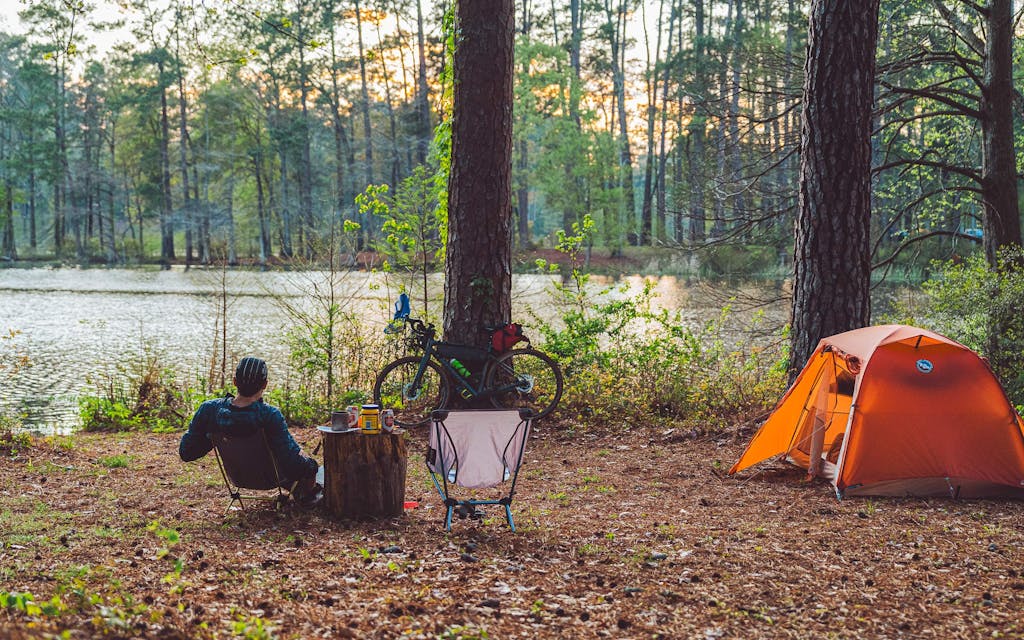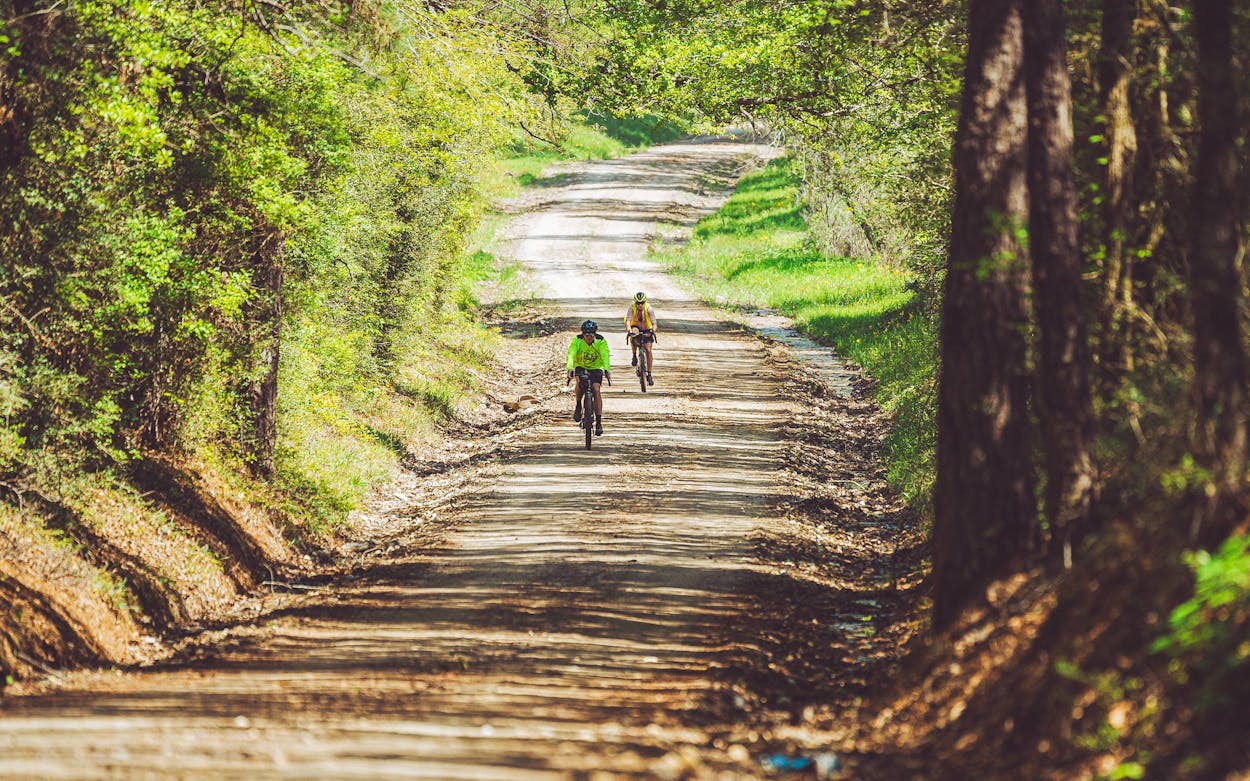On a damp March morning, I strapped bags full of camping gear to the frame of my gravel bike and joined about 250 cyclists for the fourth annual East Texas Showdown, one of the state’s biggest and longest bikepacking events. The starting line was in Point Blank, about twenty miles east of Huntsville. For the first hour or so, the pack rode east together, swarming the two-mile stretch of U.S. 190 spanning the massive breadth of Lake Livingston. Those first ten miles were deceptively smooth as we fell into pace and familiarized ourselves with the faces we’d get to know for the next 165 (or 280 or 400) miles. We said goodbye to the smooth highway as we turned onto our first gravel road. Then we hit peanut butter: thick, sticky mud with water pooled on top like the oil in a Jif container before you stir it around. I churned the pedals in an effort to keep my tires cutting through the muck, moving just barely fast enough to keep from falling over.
When cyclists sign up for the East Texas Showdown, they agree to face whatever the elements toss their way, be it loose dogs, craggy potholes, flat tires, or fearsome East Texas drivers. Bikepacking, in which riders carry everything they need to support themselves along their chosen route, was once the domain of a relatively small yet serious endurance cycling community, but in recent years it’s become more popular with weekend warriors like myself.
Along with gravel grinding, bikepacking surged in popularity during the COVID-19 pandemic, when thousands of Texans headed outdoors as a respite from cabin fever. For many, the longer distances of bikepacking are a natural progression from shorter, off-road routes. Online interest in the sport appears to have exploded since the early 2010s, with the rise of websites like Bikepacking.com, which publishes user-submitted routes and other useful information for cyclists. The sport encourages individualism, resourcefulness, and a good sense of humor to deal with unexpected challenges. The Showdown’s turnout reflects bikepacking’s popularity; it has sold out and had a waiting list every year since the event began in 2020.
Last year, a heavy rain swept East Texas the night before the race. The flood that followed broke a levy on the route, forcing some riders to wade through a waist-deep creek while carrying their bikes overhead. This time, mud threw riders for a loop on the predominantly off-road course, coating the trails for miles on end. As I watched several riders fall into the gooey, treacherous mud, I remembered something race creator Patrick Farnsworth had said the night before. “Be selfish,” he’d encouraged the crowd at the pre-race meeting. “We live in a crazy world that is full of demands. Starting now, you have the opportunity to be a steward to yourself.”


Between the 400-mile Showdown, the 280-mile Slowdown, and the 165-mile, untimed Lowdown, riders choose their own flavor of so-called type II fun. (That’s the term outdoors enthusiasts use to refer to a pursuit that is miserable while you’re doing it but seems fun with the benefit of hindsight.) As a new bikepacker, I signed up for the Lowdown and planned to finish in two days—though there is no cutoff time for any of the routes. Farnsworth said he designed the three routes as a natural progression for new bikepackers to immerse themselves in the sport. Four hundred miles may sound like a lot, but it’s actually pretty short in ultra-bikepacking terms. The sport’s Tour de France is the Tour Divide, which follows the Continental Divide for 2,750 miles between the Canadian and Mexican borders.
For Hannah Simon, a well-known ultracyclist in Austin, the East Texas Showdown served as a launch pad. She’s now completed the Triple Crown, a designation reserved for three of the longest and most difficult bikepacking races the sport has to offer: the Tour Divide, the eight-hundred-mile Arizona Trail, and the five-hundred-mile Colorado Trail.
Ultimately, Farnsworth envisions the East Texas Showdown as one in a series of three races that will serve as the Lone Star State’s answer to the Triple Crown. The routes increase in difficulty as they progress westward: The East Texas Showdown reveals what lies behind the Pine Curtain, guiding cyclists through numerous sleepy downtowns and swampy palmetto groves and into two of the region’s four national forests. The Central Texas Showdown, which Farnsworth organized for the first time last fall, takes riders up and down 22,000 feet of elevation over 467 miles in the Hill Country. Finally, the West Texas Showdown, which Farnsworth plans to launch next February, will be about 400 miles and the most difficult yet. That race will be open only to more experienced riders, who will be challenged to navigate the sparse, sprawling, and dramatic Chihuahuan Desert in and around Big Bend. “There are hardly any resupplies there. Very pokey, proddy, sunny—all the things,” Farnsworth said. “It will be the crown jewel of the series whenever it’s completed.”
Because of the nature of aerodynamics in a peloton, road cycling is infamously cutthroat. Road races such as the Tour de France often come down to a calculated chess match of positioning with other riders, which Lance Armstrong once described as a time to “get your hate on.” Off-road bikepacking couldn’t be more different. Most off-road races are solo and self-supported, so drafting off other riders is prohibited. Bikepackers fight the elements, not each other. “You have to concentrate. Not on other people—on the road,” said Dennis Lastochkin, this year’s Showdown winner, who lives in Austin. The race’s fastest riders don’t stop to sleep. This year, Lastochkin rolled into the parking lot of Point Blank’s Bullet Grill, the Showdown’s start and end point, just over thirty hours after the race began. He couldn’t let his mind wander or go on autopilot as he staved off sleep deprivation and scanned the road for potential dangers, such as cars or potholes. The hours passed quickly as he calculated the time until his next water stop, or the number of calories he needed to consume at the upcoming gas station. “It’s more of an internal competition. You’re competing against yourself, against the world, against the elements,” Lastochkin explained.
In the Showdown’s shorter-distance routes, stopping to smell the flowers is encouraged. In late March, bluebonnets, pink ladies, and Indian paintbrushes bloomed in the breaks between tall pines. I took in the views alongside Madeleine Pelzel, a Houston-based urban planner who works on bike-lane development. Like many of the Showdown riders, she lives and breathes cycling, building the sport into her career. Back at the Bullet Grill, I’d seen the classic trope of bikes more expensive than the beater cars their owners drove, but a good number of bikes riders could have been scored for $200 on Facebook Marketplace. Showdown riders spanned all ages, and I was also grateful to see some women and nonbinary individuals. But like many ultradistance sports, bikepacking is still dominated by men, who accounted for more than three-quarters of the cyclists I saw that weekend.

Pelzel and I got to know each other on the first day of the ride as we rode together for 75 miles and chatted over a gas station feast of fried pickles on a stick, hot wings, and a can of Pringles. The race brings bike nerds together, but it also acquaints them with communities along the route. “The local community really embraces the race,” said Simon. “The ladies at the Dollar General get so excited when they see us.”
Farnsworth encourages a more relaxed take on bikepacking by awarding Lowdown riders prizes for the most creative outfit and best energy on the course. The first night of the Lowdown, I joined a large group of riders who set up camp at Ratcliff Lake Recreation Area in the Davy Crockett National Forest, between Lufkin and Crockett. Two volunteers, fans of Farnsworth’s Bikes or Death podcast from Florida, grilled hot dogs for the cyclists and crew. I sipped a Yuengling by the lake before waddling back to my tent to nurse my aching quads and chaffed behind. Before setting out the next morning, I joined a group for some fireside commiseration about the previous day’s grueling mud. As one man, a Houston-based attorney, said, “It beats being in court.”
My second, longer day in the saddle was easier than the first. The sun came out and baked the mud into drier clay as I rode throughout the morning. It gleamed off the shining Trinity River as I approached Riverside, about twenty miles from the finish line. Less than two hours later, Farnsworth had his bullhorn in hand as I pulled into the parking lot of the Bullet Grill, completing my 165-mile journey. “Thanks for riding your damn bike!” he yelled. He wore a cowboy hat and tattoos poked out of his denim cutoffs. Across his right forearm, Western lettering spelled out the name of his podcast, Bikes or Death. Farnsworth started the show in 2018 as a hobby. As a type-B recreationalist, or “pro-slow,” as he’s dubbed it, he liked how recording the podcast offered him a way to connect with the endurance athletes and bikepackers he admired. But, as he soon discovered, “Podcasting is very lonely. I sit in my house and talk to people. Then, the listeners are having their own experiences that I never get to see.”
To bring people together, Farnsworth decided to start his own race. A single father who juggles recording the podcast alongside his day job in real estate, he, like most people, often struggles to fit in long rides. He wanted to create an event that amateur and elite cyclists alike could enjoy in one long weekend.
Farnsworth was born and raised in the Bryan–College Station area, where he still lives and bikes today. “We’re not the mecca for outdoor sports,” he said. “This town does not have great cycling infrastructure, and I think that’s representative of Texas as a whole.” As he soon discovered, the biggest limiting factor for his races is the state’s lack of public lands. Only about three percent of the state is publicly owned, and the public spaces that are available are often overrun with visitors. To plan a route, he needed campgrounds or other accommodations for bikepackers to sleep. He also envies the miles of low-traffic, cyclist-friendly park roads and single-track trails available in more park-laden states like Idaho, New Mexico, or Arizona.
Farnsworth decided to make use of isolated Texas country roads for his routes, but planning around the constraints takes time. “Scouting these routes can take six months to a year,” he said. “You plan it on the internet, put together a route, and find the best roads online, but then you have to go scout them in person. I’ll be out there for like a week at a time just driving around, trying different roads, and making notes. Then I’ll come back two or three times to revisit.” The process has allowed him to fall back in love with his home state and see it in a new light. “I think I sold Texas short,” Farnsworth said. “I’ve been completely awestruck by the natural beauty that is here.”
- More About:
- Cycling
- East Texas






